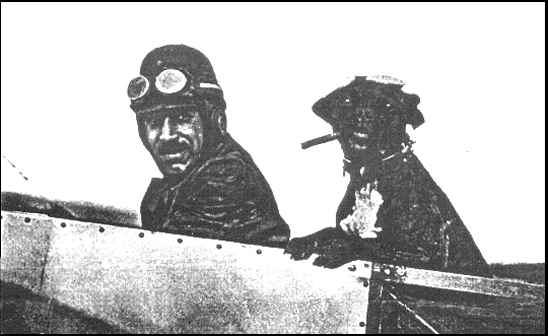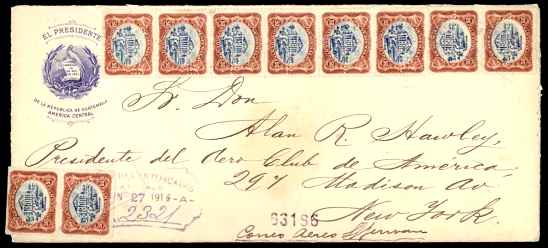
|
1881-1942 |
 |
|
Via email from Mario E. Overall - 11-3-03 Regarding our old friend S. Jerwan, well, he was quite a picturesque character, at least he was perceived in that way by the Guatemalans. Among the interesting facts about him is that back then, he taught a guy to fly who would become Guatemala's president in 1961. His name is Miguel Ydígoras Fuentes. Jerwan also flew one of the very first airplanes to be built here in this country. Unfortunately, he crashed during the first test-flight... However, the fact for which he is best remembered is that he taught all the cadets and mechanics of the Aviation Academy to play polo, at a time when there weren't any planes available. Most of the information we have about Jerwan and the other Early Birds in Guatemala, comes from an article that appeared in a magazine named "Directorio General de Guatemala", published in February 1929. Some other tidbits, the most interesting in fact, come from an article published by Mr. Ydígoras Fuentes in 1959, in a Magazine called "Revista Aérea de Guatemala". If you come across interesting pictures of S. Jerwan while he was in Guatemala, I would love to see them. So please keep me in mind. In answer to your question, yes, I am Guatemalan. Nevertheless, my grandfather and his father were British. Both served with the Royal Horse Artillery during the great war, and then they came to Guatemala to start a new life from scratch, or so they used to say. Cheers ! Mario E. Overall LAAHS Guatemala |
 |
 |
"The letter is actually from the President of Guatemala (seal at upper left corner) addressed to Alan R. Hawley, the President of the Aero Club of America. The 'Correo Aereo' endorsement with the signature would suggest that this envelope was carried on some sort of exhibition flight in Guatemala on or about 26 June 1916 by Shakir S. Jerwan prior to the envelope and its contents going into the regular mails to the USA. One can only assume that the President of Guatemala was informing Alan Hawley of the details of the exhibition flight that the envelope was carried on ..." I invite you to visit Brian's website by clicking on: |
|
Shakir S. Jerwan, hotel comptroller, Hotel Warwick, Philadelphia, soloed a Moisant monoplane August 1911, at Mineola and holds Aero Club certificate No. 54. He became chief pilot of the Moisant school. After a period of lecturing he organized aviation in Mexico and Guatemala. courtesy of Steve Remington - CollectAir |
|
Under the name Moisant's International Aviators, Ltd., the itinerant troupe started out from New York, opening in Richmond. It then went on to Chattanooga and Memphis, Tupelo (Mississippi), New Orleans, Dallas and Fort Worth, and Oklahoma City; back to Texas, with shows at Waco, Temple, Houston, San Antonio, and El Paso; across the border to Monterrey, Mexico City, and Vera Cruz in Mexico; and finally to Havana, Cuba. As might be expected, the odyssey was fraught with countless adventures and accidents---including a crash that killed the leader of the expedition hismself. With his usual flair for the dramatic, Moisant chose the last day of the year---in other words, the last possible moment---to try for the Michelin nonstop distance prize. He would have to beat a French mark of 362.7 miles in 7 hours 48 minutes 31 seconds, set by Maurice Tabuteau only the day before with a Maurice Farman biplane. But Moisant was counting on the luck that had ridden with his so far---as well as on the one Bleriot in the stable considered in good enough condition to make the attempt. Flying a short hop from the nearby racetrack, where the circus had pitched its tent, to territory more favorable for the long grind, he was coming down with the wind when a gust upended the tail of his machine. Moisant was pitched forward and out from a height of fifteen feet, breaking his neck. (By coincidence, at approximately the same hour, Arch Hoxsey---twin star with Ralph Johnstone in the altitude events at the Belmont meet---was killed at Los Angeles when he lost control of his Wright and turned over during a "spiral Glide" from a great height.) Actually, the winner of the 1910 Michelin trophy was in doubt until late that December 31; for the Alsation flyer Pierre Marie Bournique, setting record after record for speed with his R.E.P. at Buc, threatened to beat Tabuteau. Bournique covered 330 miles in 6 hours 30 minutes before having to give up. True to tradition, the show went on after the death of Moisant. John B.'s older brother Alfred took charge; and in the pleasant weather of Mexico and Cuba proficiency rapidly increased, exhibitions were more successful, and gate receipts prospered. When the tour was over and the troupers disbanded early in 1911, Alfred Moisant returned to New York and opened an aviation school at Hempstead Plains, near Garden City, Long Island, where a vast acreage was admirably adaptable to practice flying. Alfred had the assistance of Harold Kantner, and early exhibition flyer, as well as of George H. Arnold, Mortimer F. Bates, J Hector Worden,and Chief Pilot S. S. Jerwan---"all licensed aviators," as the prospectus put it. A sister, Matilde Moisant, lent glamor to the school by becoming an expert aviatrix, winning a respected place for herself among here male colleagues. |
|
August, 1911 S. S. JERWAN MAKES REMARKABLE LANDING IN QUALIFYING BEFORE AERO CLUB OFFICIALS. WINS LICENSE IN CLEVER FLIGHTS When Mr. Jerwan started out, there was a strong wind coming out of the east and at times the fog was so dense that it almost obscured the monoplane, but it soon cleared. Mr. Jerwan made his first five "eights" in fine form and then came down for his landing and stopped at the hundred foot mark. Fearing that he had not completed his full "eights" in the second round, Mr. Jerwan negotiated seven and then descended within seven feet of a designated point, cutting within a small margin of making a world's record. His altitude work was also good. He not only filled the necessary requirements of 104 feet, but went to the 250-foot mark. Baron L. de Oray and Phillip W. Wilcox represented the Aero Club of America at the test. Captain George N. MacKay, of Company A., Signal Corps, of the Michigan militia, is receiving instructions in aviation and hopes soon to win his license. He has been assigned to his work by Governor Osborn, who expects to see Michigan the first State in the Union to have a licensed aviator in the ranks of the militia. When Captain MacKay obtains his license, the State will make requisition for a two seated monoplane, which will be quipped with wireless. TRUE TALES OF THE ANCIENT AVIATORS |
|
|
|
If time permits, and if you are interested in the other features which are offered on this website, you can access it by clicking on the name of the site above. Its coverage of the subject is encyclopedic for sure. |
|
Born 2/16/1881 beirut,syria Entered u.s. 1904 In who whos in aviation 1942. PS: Do you have any info about (non-eb)roy c. votaw? He was mentioned at 1975 San Diego EB reunion Editor's Note: My thanks to Wayne for these tidbits of information. Regarding your request for information on Roy C. Votaw, I did a search on his name, using the Google search engine, and found five links. None of them satisfied my curiosity, but they were provacative. If time permits, I will pursue this question. Perhaps some of my other visitors can help. |


|